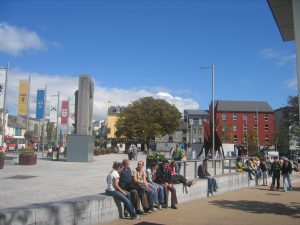 A masterplan for Galway city centre’s “eastern rim” incorporates proposals for a new “city quarter” spearheaded by the Comer/McHale consortium. Lands on Eyre Square’s east side have the potential for a “distinctive quarter” within “the historic core”, according to Galway City Council, which has been in pre-planning discussions with the developers.
A masterplan for Galway city centre’s “eastern rim” incorporates proposals for a new “city quarter” spearheaded by the Comer/McHale consortium. Lands on Eyre Square’s east side have the potential for a “distinctive quarter” within “the historic core”, according to Galway City Council, which has been in pre-planning discussions with the developers.
Mr Luke Comer of the Comer Group told The Irish Times that a”comprehensive redevelopment” of the area could resemble Belfast’s Victoria Square, with office space to attract a “flagship employer” .
Three years ago, the Comer/ McHale partnership paid a reported €14 million for a portfolio bought at the height of the boom for €170 million. The portfolio included more than 30 properties in an area embraced by Eyre Square, Prospect Hill, Bóthar Uí hEithir and Forster Street
Eyre Square’s eastern perimeter is identified as a “key opportunity site” in the new city development plan for 2017-2023.
Galway is due to become European Capital of Culture in 2020 and already holds a prestigious Unesco City of Film designation.
The Comer/McHale proposals for a “plaza” around St Patrick’s Church involve a mix of commercial and residential buildings, with a hotel, shops, offices, apartments and student accommodation.
Majority
A majority of city councillors backed the initial proposal, which would also involve a pedestrian walkway from Eyre Square through St Patrick’s Avenue to the “eastern quarter”.
Galway city manager Brendan McGrath then recommended that an objective should be included in the new city plan of developing a specific strategy for the quarter. Eyre Square is an architectural conservation area, and a masterplan would “demonstrate how new development would recognise the sensitive location”, states the proposed material alteration to the draft city plan.
“This does not infer nor necessitate the replacement of many existing structures within the block, nor alter the form . . . of the surrounding principal streetscapes,”it says.
Rather, it would show how existing structures, many of them of historic value, could be complemented and “enhanced”, it says.
The Galway diocese owns two key buildings in the area: the old St Patrick’s Church, dating from the 1840s, and the so-called “new”church, dating from the 1960s. The diocese recently issued a statement saying that neither the diocese nor St Patrick’s parish had been consulted about any plans to “sell, deconsecrate, demolish or move” either of the churches or associated parish houses and graves.
However, Mr Comer told The Irish Times that “nothing would happen without full consultation with and negotiations with” the Galway diocese.
“This part of the plan would be very sensitively handled,”he said.
Earlier this year, a landmark building on the northern perimeter of Eyre Square was sold for more than the guide price of €10.5 million. The two-storey period building used by the Bank of Ireland was sold to a private investor.
Work is still continuing on the square’s western flank on redesign of Eyre Square Shopping Centre. The centre’s existing entrance has been demolished to provide space for seven retail units, ranging in size from 12 sq m to 195 sq m (129 sq ft to 3,000 sq ft).
The centre, with anchor tenants Penneys and Dunnes Stores, incorporates more than 60 shops and a 450-space multistorey carpark and is said to attract around 189,000 visitors weekly.
Southern rim
The future of the square’s southern rim, fronted by the Meyrick Hotel, is still undecided as ambitious plans for redevelopment of the Ceannt Station site by CIÉ have been on hold since the economic downturn of 2008.
The €1 billion plan proposed by CIÉ in 2007 aimed to transform the station’s 5.6-hectare (14-acre) location off Eyre Square into a new urban centre called the Ceannt Station Quarter. It was to have involved the construction of 800 residential units, including social and affordable housing, while the railway station would expand .
CIÉ tendered at the time for a preferred developer, Mr Gerry Barrett of Edward Holdings. The former teacher, who built up a substantial property base during the 1980s, was one of the largest clients of Anglo Irish Bank and his assets in Galway included the G and Meyrick hotels and the Edward Square shopping centre. His loans were transferred over to the National Assets Management Agency (Nama) from his various Irish banks
Galway City Council says there have been some “pre-planning discussions” but no real advance on the Ceannt Station plan. It points to the potential of the city’s “Silicon Square”, a “startlab” Galway incubator or innovation hub which is located in the “PorterShed” on the station’s “campus”.
In tandem with the new city plan, Galway City Council intends to draw up a new “public realm strategy”, extending from Eyre Square west to Salthill, and including the proposed “cultural quarter” with the Galway City Museum and Picture Palace cinema near the docks.
This strategy will dovetail with the city’s transportation needs and may involve a “shared space” between pedestrians and public transport on Eglinton Street.
The public realm strategy will also be influenced by key decisions on the port and on the city’s proposed bypass, a controversial road plan which may provide a new bridge over the Corrib river but cuts through parts of the city.
The Galway Harbour Company board’s application for a new deepwater port was the subject of a Bord Pleanála strategic infrastructure hearing in January 2015. The €126 million plan to expand Galway Harbour attracted 126 submissions, including objections by Shannon Foynes Port Company and An Taisce.
